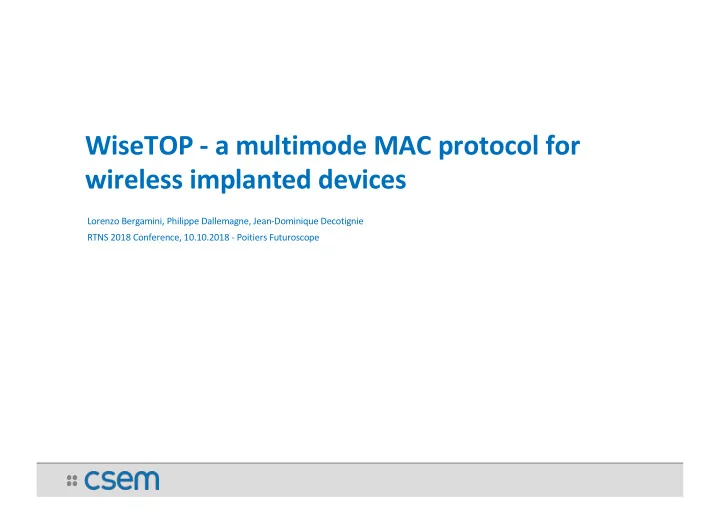

WiseTOP - a multimode MAC protocol for wireless implanted devices Lorenzo Bergamini, Philippe Dallemagne, Jean-Dominique Decotignie RTNS 2018 Conference, 10.10.2018 - Poitiers Futuroscope
Overview • Detop use-case: implanted device communication • Low power protocol requirements • Candidate solution 1 - Wisemac • Candidate solution 2 - TDMA • Selected solution - WiseTOP • WiseTOP mode switch • Energy consumption comparison • TDMA communication performance • Conclusions and future work 2
DeTOP use case
Low power wireless protocol - main requirements • Low power consumption in idle mode • Adaptable data throughput • Downlink traffic for configuration and management data • End-to-end latency below 100ms, bitrate up to 1Mbit/sec • Resistance to WiFi and other 2.4GHz technologies 4
Candidate solution 1 - Wisemac • Low power listening protocol • CSMA (carrier sense multiple access) • Preamble sampling to mitigate idle listening • Table of sampling time offsets of usual destinations to optimise consumption • Multi channel support included • Very low power consumption when traffic is low 5
Wisemac - example • Sink starts sending data with a long preamble (red) • Node 1 receives and sends ack for last repetition • Next time node 1 and sink communicates, short preamble 6
Low power wireless protocol - main requirements: Wisemac • Low power consumption in idle mode • Adaptable data throughput • Downlink traffic for configuration and management data • End-to-end latency below 100ms, bitrate up to 1Mbit/sec • Resistance to WiFi and other 2.4GHz technologies Wisemac 7
Candidate solution 2 - TDMA • Time divided in beacon intervals, i.e. the interval between 2 successive beacons • Beacon intervals divided in a fixed number of slots • One special node selected as network coordinator • Periodic transmission of “beacons” containing setup information • Only one node can transmit in a given slot; more slots can be assigned to a same node • Higher total data rate than wisemac • Multi channel support included 8
TDMA - Example Slot 0 Slot 1 Slot 2 Slot 3 Slot 4 Slot 5 Slot 6 … Slot n Gu Beacon Sink N/A Node 1 Node 1 N/A N/A Beacon ard Beacon interval Sink Reception Sleep Sleep Sleep Transmission Node 1 Sleep Sleep Sleep Node 2 Sleep Sleep Sleep Sleep Sleep 9
Low power wireless protocol - main requirements: TDMA • Low power consumption in idle mode • Adaptable data throughput • Downlink traffic for configuration and management data • End-to-end latency below 100ms, bitrate up to 1Mbit/sec • Resistance to WiFi and other 2.4GHz technologies TDMA 10
Two solutions Wisemac TDMA protocol • Low power consumption • Low power consumption • Adaptable data throughput • Adaptable data throughput • Downlink traffic for configuration • Downlink traffic for configuration and management data and management data WiseTOP Wisemac TDMA • End-to-end latency below 100ms, • End-to-end latency below 100ms, bitrate up to 1Mbit/sec bitrate up to 1Mbit/sec • Resistance to WiFi and other • Resistance to WiFi and other 2.4GHz technologies 2.4GHz technologies 11
Low power wireless protocol - main requirements: WiseTOP • Low power consumption in idle mode • Adaptable data throughput • Downlink traffic for configuration and management data • End-to-end latency below 100ms, bitrate up to 1Mbit/sec • Resistance to WiFi and other 2.4GHz technologies WiseTOP 12
WiseTOP General Architecture • Takes the best of two solutions • For no to low traffic operations, use wisemac • Periodic traffic status information are transmitted from all nodes • When traffic increases, switch to TDMA • A traffic scheduler running on the coordinator decides when to switch protocol • Dynamic channel switching to reduce impact of external interference • Reduce buffers size to fit both protocols in program memory
WiseTOP - example N1 Sink N2 Traffic is increasing, Switch to TDMA “Change protocol” G Beac Node Node Beac ua Sink N/A N/A N/A TDMA on 1 1 on rd 14
Energy consumption of the two protocols Operation Wisemac TDMA Data transmission 405 uJ 32.6 uJ Data Reception 267 uJ 43 uJ Sampling 27 uJ N/A Beacon N/A 55 uJ Transmission Beacon Reception N/A 45 uJ
Energy consumption comparison Energy consumed by the 3 protocols in 1 minute with respect to then number of packets
TDMA Protocol performance • Test scenario: 6 nodes in star topology with or without WiFi interference • Results averaged on 10 different runs • Metric: percentage of packets correctly received at sink • Without interference: 97%, with interference 94% • Latency requirements met with appropriate tuning of tdma parameters and TMM configuration (both elements are application dependent)
Conclusions and future work • Detop EU project requires a low power protocol with specific constraints • Neither Wisemac nor TDMA, alone, could comply with all of the constraints at the same time • WiseTOP is a bi-mode protocol, running both as Wisemac and as TDMA depending on the traffic status • Complete definition and analysis of TMM module for scheduling of transmissions and protocol mode switch in the specific context of the considered implanted device scenario 18
Thank you for your attention! Questions?
Recommend
More recommend